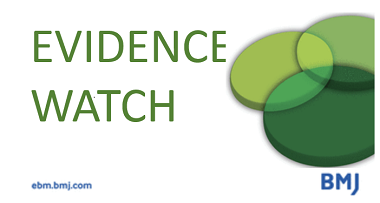Should findings from a single trial inform decision making about lung cancer screening?
Carl Heneghan, Editor in Chief
 A recent cost-effective analysis of low-dose computed tomography for lung cancer screening targeted in those at highest risk of lung cancer suggests only modest benefits. The conclusion is based on a cost-effectiveness analysis of risk-targeted screening compared with National Lung Screening trial data in the US (NLST).
A recent cost-effective analysis of low-dose computed tomography for lung cancer screening targeted in those at highest risk of lung cancer suggests only modest benefits. The conclusion is based on a cost-effectiveness analysis of risk-targeted screening compared with National Lung Screening trial data in the US (NLST).
The NLST trial done in the US concluded screening with low-dose CT reduced mortality from lung cancer. This trial in 53,454 persons at high risk for lung cancer randomised participants to three annual screenings with either low-dose CT or chest radiography. There was 247 lung cancer lung cancer per 100,000 person-years in the low-dose CT group and 309 deaths per 100,000 person-years in the radiography group.
Although this seems impressive, 20% relative reduction after 6.5 years, mortality from lung cancer was 1.3% with annual low-dose CT screening versus 1.7% with plain chest radiography.
The evidence clearly shows that screening using plain chest radiography does not reduce mortality but has high false-positive results and is not worth doing.
However, should findings from a single trial inform decision making? Particularly given the costs, the false positives (20% of patients and about 90% of nodules discovered are to be false-positives) and the potential for harms.
The Cochrane review on this subject including eight nine trials with a total of 453,965 subjects only found one RCT, the NLST trial, that showed a reduction with low dose CT screening. The results of the review report that lung cancer mortality with CT screening is reduced from 17 per 1000 to 13 to per 1000 with screening and all-cause mortality from 75 per 1000 to 70 per 1000 screened, although this sits on the boundary of significance. The review concludes: ‘annual screening is associated with a reduction in lung cancer mortality in high-risk smokers, but data on cost-effectiveness and the harms of screening across a range of different risk groups and settings are required.’
The recent cost-effective analysis in the Annals of Internal Medicine suggests that although risk targeting may improve screening efficiency, gains are modest in terms of life years, quality of life, mortality and cost-effectiveness.
However, at the end of this process, I can’t help feeling how much uncertainty there is about the best way forward. Only one trial to inform practice and many questions remain unanswered.
The Cochrane review was done in 2013, so is out of date. I think we need real-time systematic reviews that react to evidence as it emerges. Prescrire informs us that there were results from four trial available in 2013, and that interim analyses of the Dante, Dlsct and Mild studies, showed no reduction in lung cancer mortality after CT screening.
We could do with building an evidence base that genuinely informs practice. Until then I’ll leave you with the 2013 U.S. Preventive Services Task Force Recommendation:
‘Good evidence shows LDCT can significantly reduce mortality from lung cancer. However, there are significant harms associated with screening that must be balanced with the benefits. More efforts to reduce false-positive examinations are of paramount importance, and smoking cessation remains the most important approach to reducing lung cancer mortality.’
And don’t blame me if you feel as confused as I am.
References
Risk-targeted lung cancer screening a cost-effectiveness analysis. Kumar V. et al. 2018. Annals of Internal Medicine, 168(3), 161–169.
Reduced lung-cancer mortality with low-dose computed tomographic screening. National Lung Screening Trial Research Team, N Engl J Med. 2011 Aug 4;365(5):395-409.
Screening for lung cancer. Too many uncertainties, even for smokers. [No authors listed] Prescrire Int. 2014 Jan;23(145):19-23. Review.

BMJ Evidence-Based Medicine – original evidence-based research, insights and opinions on what matters for health care.
Read more about BMJ EBM content in the Welcome to BMJ Evidence-Based Medicine Editorial.
Carl Heneghan is Professor of EBM at the University of Oxford, Director of CEBM and Editor in Chief of BMJ EBM
Follow on twitter @carlheneghan
Competing interests
Carl has received expenses and fees for his media work including BBC Inside Health. He holds grant funding from the NIHR, the NIHR School of Primary Care Research, The Wellcome Trust and the WHO. He has also received income from the publication of a series of toolkit books published by Blackwells. CEBM jointly runs the EvidenceLive Conference with the BMJ and the Overdiagnosis Conference with some international partners which are based on a non-profit model.
BMJ Evidence-Based Medicine – original evidence-based research, insights and opinions on what matters for health care.
BMJ EBM accepts submissions of a wide range of article types, including original research, debate, analysis & opinion, and clinical spotlight.
Read more about BMJ EBM content in the Welcome to BMJ Evidence-Based Medicine Editorial.